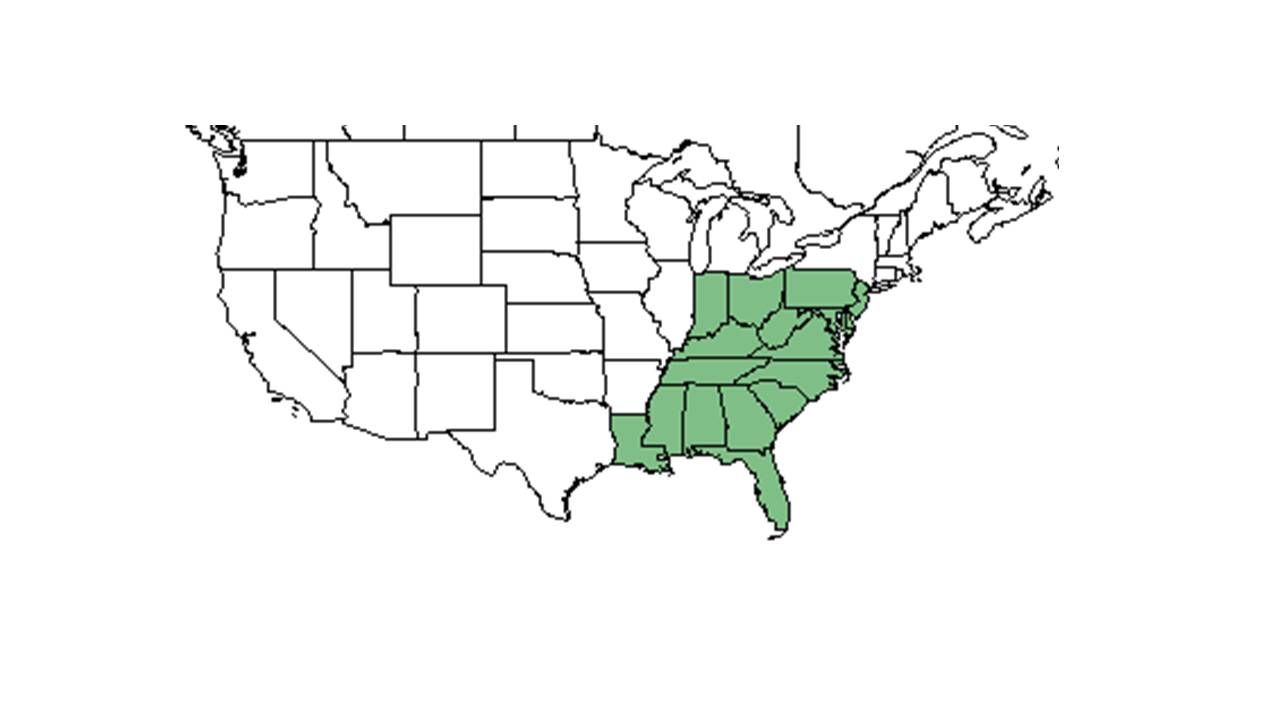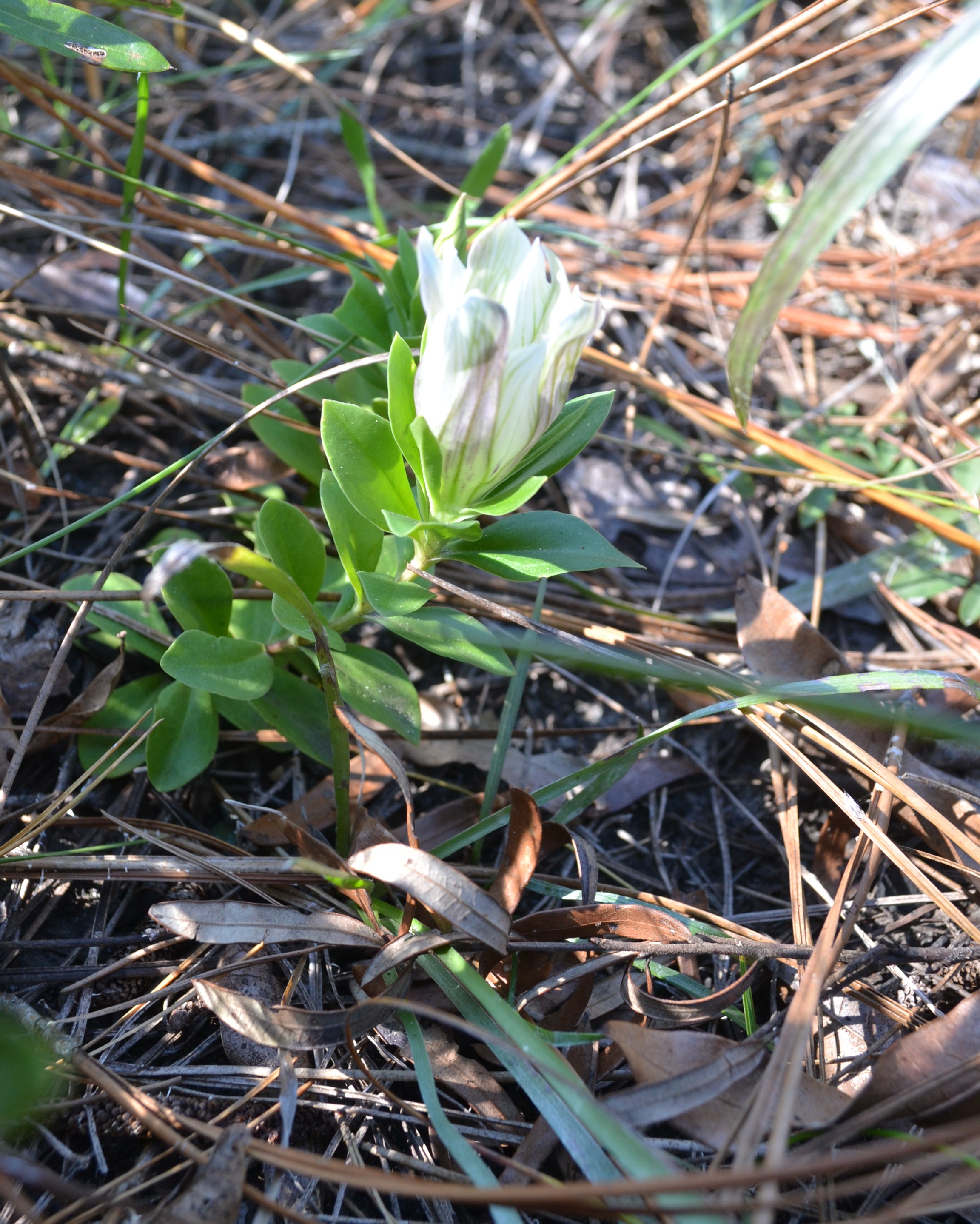Difference between revisions of "Gentiana villosa"
| (21 intermediate revisions by 7 users not shown) | |||
| Line 18: | Line 18: | ||
}} | }} | ||
| − | Common name: | + | Common name: striped gentian |
==Taxonomic notes== | ==Taxonomic notes== | ||
| − | Synonyms: ''Dasystephana villosa'' (Linnaeus) Small; ''Pneumonanthe villosa'' (Linnaeus) F.W. Schmidt | + | Synonyms: ''Dasystephana villosa'' (Linnaeus) Small; ''Pneumonanthe villosa'' (Linnaeus) F.W. Schmidt<ref name=weakley>Weakley, A.S. 2020. Flora of the Southeastern United States. Edition of 20 October 2020. University of North Carolina at Chapel Hill, Chapel Hill, North Carolina.</ref> |
| + | |||
| + | Varieties: none<ref name=weakley/> | ||
==Description== | ==Description== | ||
| Line 29: | Line 31: | ||
==Distribution== | ==Distribution== | ||
| + | ''Gentiana villosa'' can be found from southeast Pennsylvania west to northern Kentucky and western Tennessee, and south to the Florida panhandle and eastern Louisiana.<ref name=weakley/> | ||
| + | |||
==Ecology== | ==Ecology== | ||
===Habitat=== <!--Natural communities, human disturbed habitats, topography, hydrology, soils, light, fire regime requirements for removal of competition, etc.--> | ===Habitat=== <!--Natural communities, human disturbed habitats, topography, hydrology, soils, light, fire regime requirements for removal of competition, etc.--> | ||
| − | This species has been found in mixed woodlands, secondary, brushy pine-oak upland woods, longleaf pine-turkey oak sand ridges, and hillsides.<ref name=fsu>Florida State University Robert K. Godfrey Herbarium database. URL: http://herbarium.bio.fsu.edu. Last accessed: June 2014. Collectors: R.K. Godfrey, J. P. Gillespie, A. F. Clewell, R. Kral, Betty Pierce, Gary R. Knight, Rodie White, Richard R. Clinebell II, and R. Komarek. States and Counties: Florida: Jackson, Leon, Liberty, and Madison. Georgia: Grady and Thomas.</ref> It | + | Generally, ''G. villosa'' grows in sandhill or pocosin ecotones and upland forests.<ref name=weakley/> This species has been found in mixed woodlands, secondary, brushy pine-oak upland woods, longleaf pine-turkey oak sand ridges, and hillsides. It has been observed growing in rich, moist, humus in shaded locations.<ref name=fsu>Florida State University Robert K. Godfrey Herbarium database. URL: http://herbarium.bio.fsu.edu. Last accessed: June 2014. Collectors: R.K. Godfrey, J. P. Gillespie, A. F. Clewell, R. Kral, Betty Pierce, Gary R. Knight, Rodie White, Richard R. Clinebell II, and R. Komarek. States and Counties: Florida: Jackson, Leon, Liberty, and Madison. Georgia: Grady and Thomas.</ref> It is considered a characteristic species of the shortleaf pine-oak-hickory habitat found in the Red Hills Region of northern Florida and southern Georgia.<ref>Clewell, A. F. (2013). "Prior prevalence of shortleaf pine-oak-hickory woodlands in the Tallahassee red hills." Castanea 78(4): 266-276.</ref> |
| + | |||
| + | Associated species include ''Pinus palustris'' and ''Quercus laevis.''<ref name=fsu/> | ||
===Phenology=== <!--Timing off flowering, fruiting, seed dispersal, and environmental triggers. Cite PanFlora website if appropriate: http://www.gilnelson.com/PanFlora/ --> | ===Phenology=== <!--Timing off flowering, fruiting, seed dispersal, and environmental triggers. Cite PanFlora website if appropriate: http://www.gilnelson.com/PanFlora/ --> | ||
| − | This plant has been observed to flower from October to November.<ref name=fsu/> | + | It generally flowers from late August until November.<ref name=weakley/> This plant has been observed to flower from October to November.<ref name=fsu/><ref>Nelson, G. PanFlora: Plant data for the eastern United States with emphasis on the Southeastern Coastal Plains, Florida, and the Florida Panhandle. www.gilnelson.com/PanFlora/ Accessed: 17 MAY 2019</ref> |
===Seed dispersal=== | ===Seed dispersal=== | ||
| − | + | This species is thought to be dispersed by gravity. <ref>Kirkman, L. Katherine. Unpublished database of seed dispersal mode of plants found in Coastal Plain longleaf pine-grasslands of the Jones Ecological Research Center, Georgia.</ref> | |
<!--===Seed bank and germination===--> | <!--===Seed bank and germination===--> | ||
| + | |||
===Fire ecology=== <!--Fire tolerance, fire dependence, adaptive fire responses--> | ===Fire ecology=== <!--Fire tolerance, fire dependence, adaptive fire responses--> | ||
| − | + | ''Gentiana villosa'' is found in areas that are repeatedly annually burned.<ref name=fsu/><ref>Robertson, K.M. Unpublished data collected from Pebble Hill Fire Plots, Pebble Hill Plantation, Thomasville, Georgia.</ref> It has also been found in areas that are fire-excluded.<ref>Clewell, A. F. (2014). "Forest development 44 years after fire exclusion in formerly annually burned oldfield pine woodland, Florida." Castanea 79: 147-167.</ref> | |
| − | < | + | |
| − | < | + | ===Pollination=== |
| + | It is considered by pollination ecologists to be of special value to bumble bees.<ref>[[https://www.wildflower.org/plants/search.php?search_field=&newsearch=true]] Lady Bird Johnson Wildflower Center. Accessed: May 17, 2019</ref> | ||
<!--===Diseases and parasites===--> | <!--===Diseases and parasites===--> | ||
| − | ==Conservation and | + | ==Conservation, cultivation, and restoration== |
| + | ''Gentiana villosa'' is listed as endangered by the Indiana Department of Natural Resources, by the Maryland Department of Natural Resources, by the Ohio Department of Natural Resources, and by the Pennsylvania Department of Conservation and Natural Resources.<ref name= "USDA">USDA, NRCS. (2016). The PLANTS Database (http://plants.usda.gov, 17 May 2019). National Plant Data Team, Greensboro, NC 27401-4901 USA.</ref> It is also presumed extirpated in New Jersey and Washington D.C., and considered vulnerable in Louisiana and Alabama.<ref>[[http://explorer.natureserve.org]] NatureServe Explorer. Accessed: May 17, 2019</ref> | ||
| + | |||
| + | ==Cultural use== | ||
| + | In Appalachia, the plant has a variety of uses. It is believed carrying a piece of the plant on one's person increases physical strength. The roots are used to make a tonic tea for anxiety and digestion, and the rhizome can be a treatment for gout, indigestion, rheumatism, and nausea.<ref> Korchmal, Arnold & Connie. 1973. A Guide to the Medicinal Plants of the United States. The New York Times Book Company, New York.</ref> | ||
| − | |||
==Photo Gallery== | ==Photo Gallery== | ||
<gallery widths=180px> | <gallery widths=180px> | ||
Latest revision as of 19:00, 26 May 2023
| Gentiana villosa | |
|---|---|
Error creating thumbnail: Unable to save thumbnail to destination
| |
| Photo taken by Gil | |
| Scientific classification | |
| Kingdom: | Plantae |
| Division: | Magnoliophyta - Flowering plants |
| Class: | Magnoliopsida – Dicotyledons |
| Order: | Gentianales |
| Family: | Gentianaceae |
| Genus: | Gentiana |
| Species: | G. villosalink title |
| Binomial name | |
| Gentiana villosa L. | |

| |
| Natural range of Gentiana villosa from USDA NRCS Plants Database. | |
Common name: striped gentian
Contents
Taxonomic notes
Synonyms: Dasystephana villosa (Linnaeus) Small; Pneumonanthe villosa (Linnaeus) F.W. Schmidt[1]
Varieties: none[1]
Description
"Annual or perennial herbs. Stems erect, teret, often in clumps. Leaves opposite, entire, sessile to short-petiolate. Flowers solitary or in congested cymes, pedicellate or sessile. Calyx 4-5 lobed, tubular; corolla cleft ½ or less its length, campanulate, funnelform or tubular, lobes the same number as the sepals, often connected with a thin tissue (pleats); stamens 4-5, anthers free, or coherent in a ring around the style; stigmas erect, recurved in age, style short or absent. Capsule laterally compressed, elongate, stipitate; seeds 0.6-2.2 mm long." [2]
"Perennial with thick fleshy roots. Stem strict, ascending to erect, 1.5-5 dm tall. Leaves elliptic, 4-8.5 cm long, 1-3 cm wide, acute to obtuse, base attenuate to cuneate, sessile to short-petiolate. Flowers essentially sessile, solitary or in compact, 3-7 flowered cymes. Calyx 2-3.3 cm long, tube 7-13 mm long, lobes linear to narrowly elliptic, 10-20 mm long, to 3 mm wide, acute, erect to ascending; corolla greenish to yellowish white, usually tinted or striped with purple, funnel form, 3-4.2 cm long, tube 2.5-4 cm long, lobes 5, triangular-ovate, the corolla, anther adherent; stigmas spreading-recurved, style 3-5 mm long. Capsules ellipsoid to oblong, laterally compressed, 1.7-2.5 cm long, stipitate; seeds brown, ellipsoid to oblong, faintly reticulate, 1.1-1.3 mm long." [2]
Distribution
Gentiana villosa can be found from southeast Pennsylvania west to northern Kentucky and western Tennessee, and south to the Florida panhandle and eastern Louisiana.[1]
Ecology
Habitat
Generally, G. villosa grows in sandhill or pocosin ecotones and upland forests.[1] This species has been found in mixed woodlands, secondary, brushy pine-oak upland woods, longleaf pine-turkey oak sand ridges, and hillsides. It has been observed growing in rich, moist, humus in shaded locations.[3] It is considered a characteristic species of the shortleaf pine-oak-hickory habitat found in the Red Hills Region of northern Florida and southern Georgia.[4]
Associated species include Pinus palustris and Quercus laevis.[3]
Phenology
It generally flowers from late August until November.[1] This plant has been observed to flower from October to November.[3][5]
Seed dispersal
This species is thought to be dispersed by gravity. [6]
Fire ecology
Gentiana villosa is found in areas that are repeatedly annually burned.[3][7] It has also been found in areas that are fire-excluded.[8]
Pollination
It is considered by pollination ecologists to be of special value to bumble bees.[9]
Conservation, cultivation, and restoration
Gentiana villosa is listed as endangered by the Indiana Department of Natural Resources, by the Maryland Department of Natural Resources, by the Ohio Department of Natural Resources, and by the Pennsylvania Department of Conservation and Natural Resources.[10] It is also presumed extirpated in New Jersey and Washington D.C., and considered vulnerable in Louisiana and Alabama.[11]
Cultural use
In Appalachia, the plant has a variety of uses. It is believed carrying a piece of the plant on one's person increases physical strength. The roots are used to make a tonic tea for anxiety and digestion, and the rhizome can be a treatment for gout, indigestion, rheumatism, and nausea.[12]
Photo Gallery
References and notes
- ↑ 1.0 1.1 1.2 1.3 1.4 Weakley, A.S. 2020. Flora of the Southeastern United States. Edition of 20 October 2020. University of North Carolina at Chapel Hill, Chapel Hill, North Carolina.
- ↑ 2.0 2.1 Radford, Albert E., Harry E. Ahles, and C. Ritchie Bell. Manual of the Vascular Flora of the Carolinas. 1964, 1968. The University of North Carolina Press. Print.
- ↑ 3.0 3.1 3.2 3.3 Florida State University Robert K. Godfrey Herbarium database. URL: http://herbarium.bio.fsu.edu. Last accessed: June 2014. Collectors: R.K. Godfrey, J. P. Gillespie, A. F. Clewell, R. Kral, Betty Pierce, Gary R. Knight, Rodie White, Richard R. Clinebell II, and R. Komarek. States and Counties: Florida: Jackson, Leon, Liberty, and Madison. Georgia: Grady and Thomas.
- ↑ Clewell, A. F. (2013). "Prior prevalence of shortleaf pine-oak-hickory woodlands in the Tallahassee red hills." Castanea 78(4): 266-276.
- ↑ Nelson, G. PanFlora: Plant data for the eastern United States with emphasis on the Southeastern Coastal Plains, Florida, and the Florida Panhandle. www.gilnelson.com/PanFlora/ Accessed: 17 MAY 2019
- ↑ Kirkman, L. Katherine. Unpublished database of seed dispersal mode of plants found in Coastal Plain longleaf pine-grasslands of the Jones Ecological Research Center, Georgia.
- ↑ Robertson, K.M. Unpublished data collected from Pebble Hill Fire Plots, Pebble Hill Plantation, Thomasville, Georgia.
- ↑ Clewell, A. F. (2014). "Forest development 44 years after fire exclusion in formerly annually burned oldfield pine woodland, Florida." Castanea 79: 147-167.
- ↑ [[1]] Lady Bird Johnson Wildflower Center. Accessed: May 17, 2019
- ↑ USDA, NRCS. (2016). The PLANTS Database (http://plants.usda.gov, 17 May 2019). National Plant Data Team, Greensboro, NC 27401-4901 USA.
- ↑ [[2]] NatureServe Explorer. Accessed: May 17, 2019
- ↑ Korchmal, Arnold & Connie. 1973. A Guide to the Medicinal Plants of the United States. The New York Times Book Company, New York.
